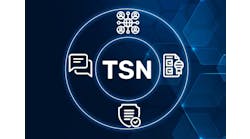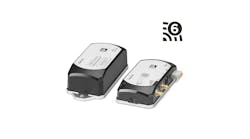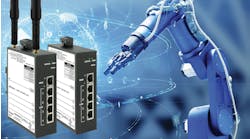10 ways time-sensitive networking will change industrial automation
1. Overloaded network
“One way that TSN can help with remote monitoring is the reason TSN is being created in the first place: it’s all about the data. One thing is clear regarding the future of industrial networks: more data is going to flow across them going forward. The ever-increasing demand for factory-level data by higher level systems, including remote monitoring, can lead to network overload. An overloaded network in a home or office is not as much of a problem as it is in an industrial environment where the consequences can halt production. This is the situation TSN is attempting to remedy before it becomes a problem. TSN will ensure time-critical data like automation traffic gets to where it needs to go on the network while maintaining openness for non-time-critical data like telemetry, diagnostics, analytics, asset management and monitoring.”
-Michael Bowne, executive director at PI North America
2. Sooner, rather than later
“TSN is a standard that brings numerous innovations and advantages to the industry. It is, on the one hand, allowing deterministic communication over standard Ethernet and, on the other hand, driving the convergence of IT and OT networks for the benefit of Industry 4.0 and IIoT use cases, such as predictive maintenance, process optimization and machine learning. Regardless of the inevitability of TSN continuing to evolve over the years, the core standards of TSN are stable. We can soon expect TSN-based products from all major automation and network component suppliers. TSN has a complexity that should not be underestimated; industry should be proactive by dealing with TSN sooner than later—to strategically migrate efficiently and exploit the potential of TSN at an early stage.”
-Peter Lutz, director field level communications, OPC Foundation
3. Autoconfiguration
“TSN network configuration is undergoing substantial improvements that will support the large-scale adoption of this technology, as key automatic tools are being developed. These will support user-friendly, plug-and-play autoconfiguration of new devices as opposed to the existing manual activities. As a result, businesses will benefit from substantial time saving and will not require specialized staff to perform these tasks. More precisely, determinism will allow the network to adapt when end users install new devices. For example, the network will be able to recognize and support the device by determining its data transfer needs and allocating time slots for data sharing. If the device is off or purposefully disconnected, the network should be aware of that, removing any assigned time slots to maximize bandwidth utilization. Autoconfiguration will also positively impact network management and support activities. By making the network smart, this tool is offering an accessible and intuitive infrastructure that is easy to interact with.”
-Thomas Burke, global strategic advisor for CC-Link Partner Association
4. From wired to wireless
“Wireless TSN has the potential to radically transform networking scope and capabilities across numerous industries. Industrial and manufacturing are two major opportunities, as well as professional media, transportation, enterprise and consumer applications and more. For example, in an industrial setting, where robotics require mobility, flexibility and reconfigurability of tasks, wireless TSN brings value by supporting the remote control, programming, diagnostics, navigation and real-time control of robotics without requiring them to be fixed in place. This allows for the performance of time-sensitive tasks with very precise synchronization across devices, creating a flexible and highly reliable industrial network.”
-Dave Cavalcanti, wireless TSN workgroup chair at Avnu Alliance and principal engineer at Intel
5. From old to new: gateway mechanisms
“Vast industry implementation will take quite a bit of time as the majority of switches, controllers and devices need to be able to support 60802 TSN in order for the benefits to be realized. New manufacturing cells and lines that are specified to be 60802 conformant will be able to take advantage of 60802 TSN early on. The development of gateway mechanisms to allow older devices to fairly co-exist on a 60802 time-sensitive network will also help drive usage in existing facilities.”
-Dr. Al Beydoun, president and executive director at ODVA
6. Plug-and-play
“Machine builders and end-user engineers should know that TSN standards are complete and published by IEEE and that a range of TSN products are already available on the market. Field-programmable-gate-array-based solutions are a good way to implement TSN quickly into industrial devices, and mass-produced application-specific integrated chips (ASICs) are lowering the cost of solutions further. Key to the adoption of TSN is that it is interoperable and easy to use. Increasingly available embedded network planning tools allow the automatic configuration of any TSN network or device. This results is a network that requires far less engineering know-how than fieldbuses and enables plug-and-play operation.”
-Thomas Berndorfer, member of the executive board of TTTech Industrial
7. Legacy support
“Because TSN is an extension of VLAN bridging with time awareness, there is the chance to migrate from protocols over normal Ethernet like UDP/IP step by step to TSN. With more and more third parties that offer services that communicate over Ethernet protocols and, on top of it, vendor-independent services for data exchange like OPC UA or DDS, there is a likelihood that TSN, or relevant parts of it, becomes the common standard. The adoption of TSN by owners and sponsors of legacy industrial Ethernet like Profinet V2.4 or CC-Link IE TSN gives it another push.”
-Michael Zapke, industrial lead at Xilinx.
8. Control-to-control communication
“We notice in factory automation a high customer demand for control-to-control communication and expect the first usage in this application. First application example may be the network between the stations of an assembly line, which has to support both guaranteed, short response times for process control and high-volume data transfer for quality assurance purposes. In subsequent evolution step applications with cross control electronic line shaft will benefit from TSN time synchronization and scheduling functionality. Application examples which require these features are packaging lines or printing machines.”
-Dr. Thomas Brandl, product owner, PLC at Bosch Rexroth
Also read: Time-sensitive networking awakening looms
9. TSN profiles
“TSN development will depend on profiles, which are collections of features taken from some or all the standards to meet a particular need. The first of these, which is a real-time machine-to-machine profile, is currently being finalized. A controller-to-device profile is expected thereafter. TSN will be able to support multi-PLC configurations carrying status, configuration, control, video, audio and motion control data over the same media. Real-time machine-to-machine communications will be possible, while having a combination of PLCs in one TSN domain will lead to virtual PLCs.”
-Phil Marshall, CEO of Hilscher North America
10. IT and OT data together
“With the developments in standards, Ethernet communication in the future is set to provide calculable end-to-end latencies, strictly limited latency fluctuations, and extremely low packet loss. TSN sits on top of standard Ethernet and defines a set of standards for enabling system designers to use an Ethernet network to transmit IT and OT data on a shared connection. IT and OT data have conflicting requirements; IT traffic typically consists of more data than OT traffic, and best-effort communication usually suffices. OT traffic, on the other hand, is time-critical. Typically, strict timing, delay and latency constraints apply. With TSN, system designers can use an Ethernet network to transmit IT and OT data on a shared connection.”
-Daniel Weiss, senior product manager, Newark






